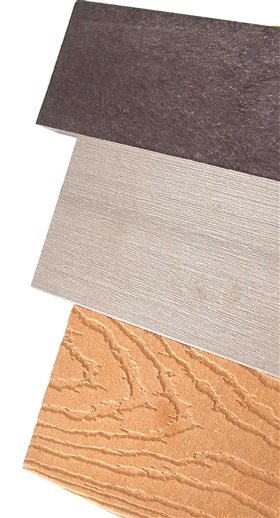We may receive a commission when you use our affiliate links. However, this does not impact our recommendations.

10 Things You Need to Know About Plastic Lumber
By Brad Holden
No, we haven’t
changed our name
to American Plasticworker.
I love wood, with all its beautiful textures,
figures and smells. But I also enjoy experimenting
with different materials. So I decided
to try some of the plastic lumber available at my
local home center. It costs $3 to $6 per bd. ft.—considerably
more expensive than treated pine, which
costs about $2 per bd. ft. at my lumberyard. Plastic
wood also holds little of the beauty and romance of
real wood, but its big advantages are durability and
the fact that it requires no finishing and little maintenance
other than an occasional rinse with the garden
hose. I also like the idea that many brands are
made from recycled materials that would otherwise
end up in a landfill. Some manufacturers sell only
the plastic boards; others also sell plastic wood furniture
and furniture kits (see "Where to buy it" and
Source, below). Of course, you can also design
and build your own plastic lumber furniture, but
you need to consider several things when you do.
1. It's very durable.
Plastic wood is particularly well-suited
for outdoor furniture. It is unaffected by water
and has ultraviolet (UV) inhibitors added to protect
it from the damage caused by long-term
exposure to the sun. This means it will last a
long time without cracking, warping or rotting.
|
|
Click any image to view a larger version.

|
2. Choose from two types
Two primary types of plastic lumber are available.
One is all plastic. The other is a composite made of
plastic and wood fiber. Some of the plastic that goes
into this lumber is new, but most comes from recycled
milk jugs, pop bottles, grocery bags and similar
waste plastic. The manufacturers of the composite plastic
lumber add ground-up waste wood. This
makes the lumber stiffer than the all-plastic type.
You may find flecks of other colored plastic on the
inside of some all-plastic boards. This is due to the
recycled nature of the material. Also, when you cut
the all-plastic material, you will notice air bubbles of
varying sizes in the core of some boards. One board
may have no bubbles, but another may have many.
|
|

|
3. Lots of colors and sizes are available
Plastic lumber comes in a wide assortment of colors and
sizes. The selection varies among brands (see "Where to buy it" below).
Composite plastic lumber comes mainly in subdued earth
tones; the all-plastic products come in a range of
bold colors. Both types offer sizes
comparable to construction lumber.
You will find, for example,
1x, 2x and 5/4 boards,
even 4×4 and 6×6 posts.
Most manufacturers offer
lengths up to 16 ft.
And 4 x 8-ft.
sheet stock is
also available
in 1/4-in. or
greater thicknesses.
|
|

|
4. Caution: It can sag
All-plastic lumber bends easily under weight.
The wood fibers make the composite-plastic lumber
stiffer, but not as stiff as the real stuff. Adequate support
is important when you’re building with all-plastic
or composite lumber. Most manufacturers recommend
16 in. as the maximum span for 5/4-thick material
when you use it as decking material. Because of its flexibility,
plastic lumber should never be used in a structural
application, such as joists or a supporting wall.
High summer temperatures can also cause sagging.
When using plastic lumber to build outdoor furniture,
you should plan to beef up your design to avoid flexing
or sagging; you may have to experiment a bit.
|
|

|
5. It's heavy
At 4 to 5 lbs. per
bd. ft., plastic wood
is heavier than oak.
Here are some numbers
for comparison.
|
|

|
6. Texture provides traction
The majority of plastic lumber
is manufactured with some kind
of texture on at least one side. Some types
have wood grain; others have a random pattern.
These textures offer visual appeal and provide traction
for decking use. A number of the manufacturers
make a board that has a “flip side,” with
wood grain on one side and a smoother pattern
on the other. These textures are only on the surface,
so if you don’t like either face, you can
plane them off. I find this a big plus when
building furniture. It gives you design
options: textured, smooth or planed.
Fun fact: An Adirondack chair
made from recycled
plastic lumber keeps
approximately 400
milk jugs from going
into a landfill.
|
|

|
7. It's fun to bend
I had a lot of fun bending plastic lumber. The
all-plastic material in particular is unbelievably
bendable when heated. Because of this, it works
very well for decorative projects, such as a garden
trellis (see right top photo).
One really cool method is to use a heat gun on the all plastic
stuff and bend or twist it as you would wrought
iron. Using a form, you can create some pretty intricate
shapes. Obviously, the smaller the stock, the sharper the
bend you can make. You have to thoroughly heat the
material until the surface starts to bubble slightly and
look almost liquid
for it to become
really pliable. Also,
leave the bent
piece in the form
until it has completely
cooled or it
will spring back. This
heat gun technique
doesn’t work on the
composite lumber,
though, because the
wood fiber starts to burn
before the part becomes
bendable.
To bend larger boards (see middle photo), you can make an inexpensive
heating oven (see bottom photo). The plastic
lumber needs to be heated to 125 degrees
to its core, which can take an hour or two.
You can then bend the board around a form
until it’s cool. Plastic lumber will spring back
when you take it off the form, so you should
do some experimenting first and bend it to a
tighter radius than you want. The composite
lumber is not as bendable as the all-plastic lumber
and will break like particleboard if you
bend it too far.
|
|

This bent 1×4 all-plastic
board was
heated in the
oven, bent by
hand around a
form and then
clamped in place
to cool. It sprang
back about 50
percent when I
took it out of the
form.

Bending thin strips of plastic lumber is
very easy. With a heat gun, a bending
jig and a little creativity, you can open
up a world of possibilities.

Make
this simple 6-
ft.-long oven from
hardware-store materials
to heat larger boards for bending.
Note: I’ve cut an opening in the top
only to show you what the inside looks like.
|
8. Where to buy it

9. Work it as easily as wood
You can plane it,
saw it—you name it.
Plastic lumber can be
cut and shaped using ordinary
woodworking tools. I
tried some common hand
tools—hand planes, chisels,
saws—and found little difference
from using them on
wood. OK, hand-planing a
piece of plastic does seem
inherently weird, but it works
quite well and there’s no
grain direction to worry
about. Using hand tools on
the composite lumber was
slightly more difficult than
using them on all-plastic
pieces.
Plastic lumber machines
great with power tools. It’s
just as easy as wood! Power
tools zip right through it.
When routing, you will get
clean, crisp edges and no
splintering. It’s comparable
to working with pine or
poplar. It is more abrasive
than wood, though, so use
carbide tools. I found dust
collection to be very important.
It’s needed not only to
collect the dust but also the
plastic shavings, which tend
to pick up a static charge and
stick to everything, including
clothes. To get all the shavings
off, I had to vacuum my
clothes.
Screwing and bolting are
the preferred fastening methods.
Gluing is generally not
recommended, because no
available glues stick very well
to this type of plastic. I had
some success with epoxy, but
the test joints I tried still
broke more easily than a similar
wood joint. Epoxy might
be useful in some situations,
but you should still secure the
joint with screws or bolts if it
will be exposed to any stress.
Screws can be driven without
predrilling, but the material
tends to pucker around the
head and may crack when
screwed near the edge.
Predrilling and countersinking
remove the risk of cracking
and will produce a cleaner
look around the head.
Stainless steel or coated deck
screws are the best choices
for outdoor use.
|
|

|
10. It's great for the patio
This bench may not end up in an
art museum, but it’ll be great on
the patio by the barbecue. All the
parts are composite-plastic lumber.
I beefed up the design by
using all 5/4 materials and adding the center
leg for extra support.
I avoided visible fasteners on the top
and apron by pocket-screwing from
underneath.
|
|

|
Product Recommendations
Here are some supplies and tools we find essential in our everyday work around the shop. We may receive a commission from sales referred by our links; however, we have carefully selected these products for their usefulness and quality.






















